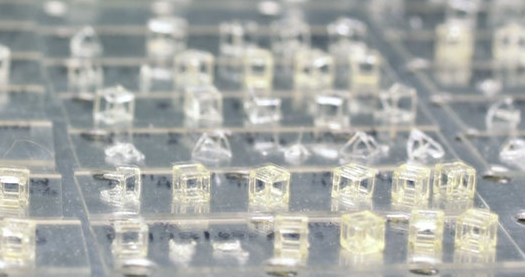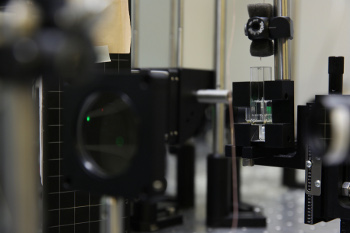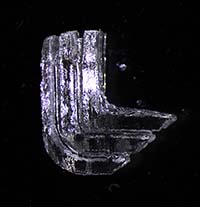 |
| January 23, 2018 | Volume 14 Issue 03 |
Designfax weekly eMagazine
Archives
Partners
Manufacturing Center
Product Spotlight
Modern Applications News
Metalworking Ideas For
Today's Job Shops
Tooling and Production
Strategies for large
metalworking plants
3D printing with instant results? LLNL can do that

By using laser-generated 3D images flashed into photosensitive resin, researchers at Lawrence Livermore National Laboratory, along with academic collaborators, have discovered they can build complex 3D parts in seconds.
Edited by Mike Foley, Designfax
Instant gratification has come to 3D printing in a very big -- and a very little -- way, thanks to new, demonstrated advances by researchers at Lawrence Livermore National Laboratory (LLNL). Using laser-generated 3D images flashed into photosensitive resin, the team has discovered they can build complex 3D parts in a fraction of the time it takes using traditional layer-by-layer printing.
The big news is the innovative process and the speed it provides to get results. While additive manufacturing (AM), commonly known as 3D printing, is enabling engineers and scientists to build parts in configurations and designs never before possible, the impact of the technology has been limited by layer-based printing methods, which can take up to hours or days to build three-dimensional parts, depending on their complexity.
LLNL's new "volumetric" 3D printing creates parts by overlapping three laser beams that define an object's geometry from three different directions, creating a hologram-like 3D image suspended in the vat of resin. The laser light, which is at a higher intensity where the beams intersect, is kept on for about 10 seconds, enough time to cure the object. The excess resin is drained out of the vat, and, seemingly like magic, researchers are left with a fully formed 3D part.
The novel approach is described in the journal Science Advances, published online Dec. 8. The development team also included researchers from the University of Rochester and the Massachusetts Institute of Technology (MIT).
But sometimes big things come in small packages. The little news is, well, the part itself. It's tiny -- at least for now.
"Our build volume was 1 cubic centimeter (10 mm x 10 mm x 10 mm)," Maxim Shusteff, Ph.D., told Designfax exclusively, "but this isn't an inherent limitation of the technique." Shusteff is a Staff Engineer and Principal Investigator at LLNL, affiliated with the Center for Engineered Materials and Manufacturing, the Center for Micro-, Meso-, and Nanotechnologies, and the Center for Bioengineering.
"Purely speculatively," said Shusteff, "based on estimates from our understanding of the optics and the photochemistry, this could be increased 10x in each direction simply by using a higher-power light source and a larger container."
"The fact that you can do fully 3D parts all in one step really does overcome an important problem in additive manufacturing," said Shusteff, who is also the paper's lead author. "We're trying to print a 3D shape all at the same time. The real aim of this paper was to ask, 'Can we make arbitrary 3D shapes all at once, instead of putting the parts together gradually layer by layer?' It turns out we can."
VIDEO: LLNL's volumetric 3D printing -- Additive manufacturing in a fraction of the time. [No sound]
The approach, the scientists concluded, results in parts built many times faster than other polymer-based methods, and most, if not all, commercial AM methods used today. Due to its low cost, flexibility, speed, and geometric versatility, the researchers expect the framework to open a major new direction of research in rapid 3D printing.
"It's a demonstration of what the next generation of additive manufacturing may be," said LLNL engineer Chris Spadaccini, who heads Livermore Lab's 3D-printing effort, in a lab statement on the innovation. "Most 3D-printing and additive manufacturing technologies consist of either a one-dimensional or two-dimensional unit operation. This moves fabrication to a fully 3D operation, which has not been done before. The potential impact on throughput could be enormous -- and if you can do it well, you can still have a lot of complexity."
With this process, Shusteff and his team printed beams, planes, struts at arbitrary angles, lattices, and complex and uniquely curved objects. While conventional 3D printing has difficulty with spanning structures that might sag without support, Shusteff said, volumetric printing has no such constraints; many curved surfaces can be produced without layering artifacts.
"This might be the only way to do AM that doesn't require layering," Shusteff said. "If you can get away from layering, you have a chance to get rid of ridges and directional properties. Because all features within the parts are formed at the same time, they don't have surface issues."
"I'm hoping what this will do is inspire other researchers to find other ways to do this with other materials," he added. "It would be a paradigm shift.

In volumetric 3D printing, the laser light, which is at a higher intensity where the beams intersect, is kept on for about 10 seconds -- enough time to cure the object.
Shusteff said volumetric printing could be made even faster with a higher-power light source. Extra-soft materials such as hydrogels could be wholly fabricated, he said, which would otherwise be damaged or destroyed by fluid motion. Volumetric 3D printing also is the only additive manufacturing technique that works better in zero gravity, he said, expanding the possibility of space-based production.
So far, the team has tested transparent photo-polymers -- liquid resins that harden into a solid. "This is very similar to the types of materials used by any stereolithography (SLA) 3D printer, and the available chemistries are very similar," Shusteff told Designfax. "We chose these polymers partly because they have widespread use in SLA and related technologies and are receiving a lot of research attention, so their performance is constantly improving. Because this initial study was really the first proof of concept of building 'all at once' 3D structures, we haven't yet had a chance to explore the full breadth of the materials, nor do rigorous testing of the material properties."
In one interesting twist, LLNL researchers have also incorporated other materials into the liquid photopolymer, like metals and ceramic particles, or done replica molding after the part is fabricated. "After printing, the polymer is removed, so the final structure can be made out of metal or ceramic," Shusteff explained. "We expect that similar techniques can be used to expand the usable materials range, but the resin volume has to be transparent (also attainable by using different, not necessarily visible, wavelengths of radiation). These are, of course, research efforts in their own right."
The technique does have limitations, the researchers said. Because each beam propagates through space without changing, there are restrictions on part resolution and on the kinds of geometries that can be formed. Extremely complex structures would require lots of intersecting laser beams and would limit the process, they explained.

Researchers printed the LLNL logo using the new "volumetric, 10-second 3D-printing technology.
Spadaccini added that additional polymer chemistry and engineering also would be needed to improve the resin properties and fine-tune them to make better structures.
"If you leave the light on too long it will start to cure everywhere, so there's a timing game," Spadaccini said. "A lot of the science and engineering is figuring out how long you can keep it on and at what intensity, and how that couples with the chemistry."
The work received Laboratory Directed Research and Development (LDRD) program funding. Additional LLNL researchers who contributed to the project were Todd Weisgraber and Robert Panas, Lawrence Graduate Scholar and University of Rochester Ph.D. student Allison Browar, UC Berkeley graduate students Brett Kelly and Johannes Henriksson, along with Nicholas Fang at MIT.
Shusteff told Designfax the initial seeds of the project were sown about five or six years ago -- when he wasn't involved with project yet. "A couple of my coauthors (Spadaccini and collaborator Prof. Nick Fang at MIT) conceptualized building a 3D structure all at the same time. They wanted to explore whether it might be possible to project a light pattern that would form the entire structure all at once, and immediately thought of holography as a possible approach, since holograms are a great way to capture and reconstruct 3D geometries," he said.
"The overlapping of multiple beams (holographic or not) was a variation of the idea floating around for a while, and we received internal LLNL research funding to pursue this idea about three years ago. That was the point when I took up the challenge of doing this in earnest and developed the details of how this method could be made to work."
"Perhaps one important 'aha' moment," said Shusteff, "was realizing that multiple intersecting beams would perform better than a single, digitally generated hologram."
Obviously, this technology is in its infancy. But what a great start.
"We've had some interest from a variety of companies, both from the process/machine side, and the materials/feedstock development side," said Shusteff. "We're discussing possible ways forward with them, but the technology still needs to ripen just a bit more before commercial viability can be properly assessed. At this point, it's still premature to say who will be doing what with it."
----------------------------------
----------------------------------
SIDEBAR: Is the volumetric process like Carbon3D's "Terminator 2" CLIP 3D-printing technology?
If you've been following the development of 3D-printing technologies over the past few years, especially resin-based processes, you may think that you've seen something akin to the volumetric process before, where parts seem to magically grow from a heated resin bath. You would be right, but the processes and results are very different.
Inspired in part by a scene in Terminator 2, the Continuous Liquid Interface Production (CLIP) 3D-printing technology from a company called Carbon3D harnesses light and oxygen to grow objects from a pool of resin instead of "printing" them layer by layer.
Designfax featured the technology in 2015 in April ("Totally new 3D-printing technology is sci-fi tech right out of the movies") and August ("Ford using Carbon3D's 'Terminator 2' CLIP 3D-printing technology).
Carbon3D's CLIP technology uses a tunable photochemical process instead of the traditional mechanical approach, eliminating some of the shortcomings of conventional layer-by-layer 3D-printing technology, to rapidly transform 3D models into physical objects. CLIP carefully balances the interaction of UV light (which triggers photo polymerization) and oxygen (which inhibits the reaction), allowing for continuously grown objects from a pool of resin. The resulting parts boast mechanical properties that are applicable for a range of industries, including aerospace, industrial goods, medical, dental, and automotive.
So isn't this kind of like LLNL's new volumetric process? Well, no.
"The fundamental concept here is quite different from Carbon3D," LLNL's Shusteff told Designfax. "Though it allows for continuous 'growth' of an object, CLIP is still fundamentally a layer-by-layer process (the layers are just extremely fine, much finer than most other layer-by-layer methods). In our approach, we get away from layer-by-layer altogether, and polymerize the entire structure of interest all at once. In that respect, this process is not evolutionary, but rather a new paradigm."
"You are quite right to note the similarity with CLIP in terms of taking advantage of oxygen (O2) inhibition," Shusteff said. "However, for Carbon3D the inhibition prevents unwanted adhesion to the window that transmits the UV light, where in our case O2 inhibition actually helps to define the 3D structure and limit the extent of polymerization."
Note: An update on Carbon3D's CLIP technology was featured in Designfax in May 2016. See "'Terminator' 3D printer now available to the masses."
Source: Lawrence Livermore National Laboratory
Published January 2018
Rate this article
View our terms of use and privacy policy
